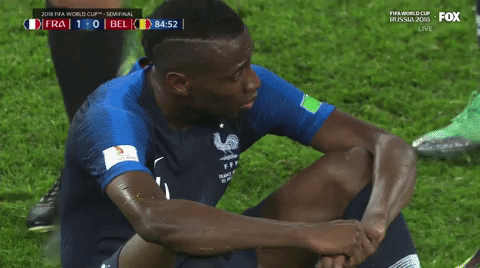Soccer's concussion problem exposed once again in World Cup semifinal
Everybody remembers the image: Of Germany’s Christoph Kramer staggering off the field in the 2014 World Cup final, half-conscious, half-zombie-like. He was concussed – he’d later say he remembered nothing of his half-hour in the game – yet allowed to stay on, until he was physically unable to continue. And his pale, expressionless face became the face of soccer’s concussion problem.
As of Tuesday, and the first of two 2018 World Cup semifinals, we now have a new face:
— Nate Scott (@aNateScott) July 10, 2018
Blaise Matuidi was crunched to the turf late in the second half of France’s 1-0 win over Belgium, clattered into by Eden Hazard. And he so clearly was not himself:
This player was sent back onto a World Cup field after a <2-minute evaluation:https://t.co/dkWtT7olxt pic.twitter.com/cA3wveiCGB
— Henry Bushnell (@HenryBushnell) July 10, 2018
He was tended to by teammates …

treated on the field by team doctors, one propping him up from behind, the other seemingly conducting an evaluation. He was soon helped off the field.

And literally 15 seconds after leaving the field, he was back on. Never mind that concussion evaluations take roughly 10 minutes minimum, nor that symptoms sometimes appear hours later. And never mind that any legitimate evaluation surely would have raised red flags.
Matuidi played about one more minute. He seemed a bit spacey. And then he sunk back to the turf:

Teammates and opponents tried to lend him a hand. He seemingly had no idea what was going on:

He staggered up to his feet, barely. As he was again helped off the field, he mostly missed his mouth when he attempted to spray water in it:
Well cheeky from Matuidi he knew exactly what he’s doing with the water bottle pic.twitter.com/2bAMw8uc6c
— Martin Corrigan (@CorrigantheJock) July 10, 2018
This time he was subbed off, as he should have been three minutes earlier. But there was nobody to enforce a sub. Nothing to ensure a proper evaluation. Matuidi’s injury – whether or not it was a concussion – is yet another example of soccer’s problem.
FIFA’s, soccer’s mishandling of concussions
The problem is systemic. One could argue Matuidi might not have suffered a concussion. But the uncertainty highlights the issue: Soccer doesn’t allow for proper evaluations, because teams can’t afford to play down a man for 10 minutes.
Something has to be done. Temporary substitutions? Fourth subs reserved specifically for potentially concussed players? Independent neurologists on sidelines to take return-to-play decisions out of teams’ hands? Outlawing or partially outlawing headers?
All solutions have their flaws. But they’d be something – more than what FIFA and other soccer governing bodies have done.
FIFA has turned a blind eye to traumatic brain injuries for years. It has concussion protocol. But nobody follows it. And FIFA doesn’t punish teams when they don’t.
So FIFA and the teams continue to conspire to put people like Matuidi at risk. It’s irresponsible. It has been and will be damaging to players’ long-term health. But FIFA and others seem quite content to carry on endangering those players, as long as the sport remains profitable and beloved.
Oh, and by the way: If Matuidi is ultimately diagnosed with a concussion, and if France acts responsibly, Matuidi won’t be able to complete FIFA’s return-to-play process in time for the World Cup final.
Or France could just ignore protocol, like Morocco did earlier in the tournament. Chances are FIFA won’t enforce its own rules.
– – – – – – –
Henry Bushnell covers global soccer for Yahoo Sports. Have a tip? Question? Comment? Email him at henrydbushnell@gmail.com, or follow him on Twitter @HenryBushnell, and on Facebook.
More World Cup on Yahoo Sports:
• World Cup semifinal preview: 4 things to watch
• Why soccer players flop
• The dark side of Croatian soccer
• The corruption scandal that enabled England’s run
• What does “football’s coming home” even mean?


